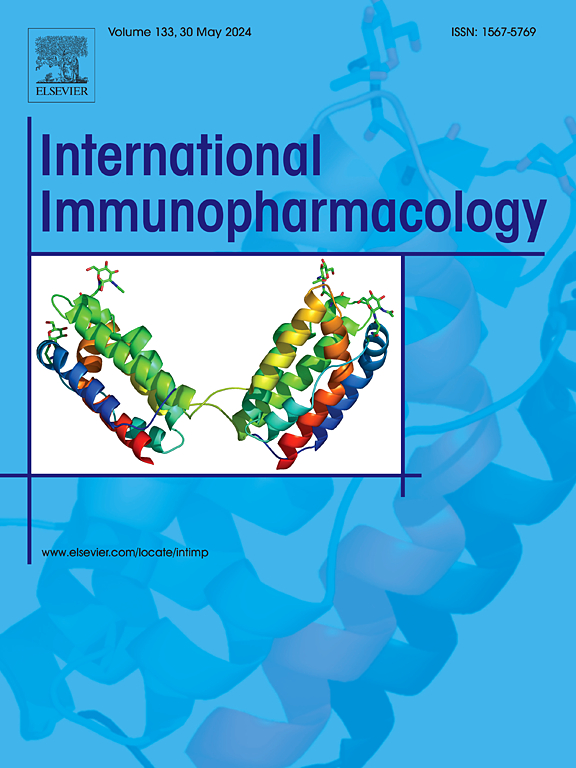Morusin通过CCL4-CCR5轴调控M2巨噬细胞和GBM细胞的迁移。
IF 4.8
2区 医学
Q2 IMMUNOLOGY
引用次数: 0
摘要
背景:胶质母细胞瘤(GBM)是中枢神经系统最具侵袭性的肿瘤。肿瘤相关巨噬细胞(tumor associated macrophage, tam)是肿瘤微环境(tumor microenvironment, TME)中的主要免疫细胞群,发挥免疫抑制作用,阻碍GBM的治疗。桑椹素是一种从桑树中提取的类黄酮,对包括胶质瘤在内的各种癌症具有抗肿瘤特性。然而,morusin对胶质瘤TME的影响尚未探讨。方法:采用小鼠胶质瘤模型,通过体内实验和体外实验,评价松茸素对肿瘤微环境的影响。体外实验证实了morusin对RAW264.7和THP1细胞的活力以及M2巨噬细胞的迁移能力的影响。此外,我们还研究了条件培养基(CM)处理的M2巨噬细胞对胶质母细胞瘤细胞系GL261、U87和U251迁移的影响。结果:松茸素通过抑制巨噬细胞与CD206+巨噬细胞的比例,减缓GBM的进展,延长小鼠的生存期。在机制上,我们证明了morusin可以有效地抑制M2巨噬细胞中趋化因子CCL4的分泌,从而降低CCL4依赖性CCR5的激活。这导致巨噬细胞和胶质母细胞瘤细胞在TME中的迁移减少。这些发现为开发morusin作为GBM的潜在治疗剂提供了强有力的理论依据,无论是作为单独治疗还是与其他免疫治疗策略联合使用,都值得进一步的临床前和临床研究。本文章由计算机程序翻译,如有差异,请以英文原文为准。
Morusin regulates the migration of M2 macrophages and GBM cells through the CCL4-CCR5 axis
Background
Glioblastoma (GBM) is the most aggressive tumor in the central nervous system. Tumor-associated macrophage (TAMs) represent a major immune cell population in tumor microenvironment (TME) and exert immunosuppressive effects that impede GBM treatment. Morusin is a flavonoid extracted from mulberry trees and has anti-tumor properties against various cancers, including glioma. However, the impact of morusin on the TME of gliomas has not been explored.
Methods
We evaluated the effect of morusin on the tumor microenvironment using a mouse glioma model through in vivo and in vitro experiments. In vitro experiments demonstrated the effects of morusin on the viability of RAW264.7 and THP1 cells, and the migration ability of M2 macrophages. Furthermore, we investigated the effect of conditioned medium (CM) of morusin-treated M2 macrophages on the migration of glioblastoma cell lines GL261, U87, and U251.
Result
Morusin alleviated the GBM progression and prolonged mouse survival by inhibiting the ratio of macrophages to CD206+ macrophages. Mechanistically, we demonstrated that morusin could effectively inhibit the secretion of the chemokine CCL4 in M2 macrophage which consequently decreased CCL4-dependent CCR5 activation. This leads to the reduced migration of both macrophages and glioblastoma cells in TME. These findings provide a strong rationale for the development of morusin as a potential therapeutic agent for GBM, either as a standalone treatment or in combination with other immunotherapeutic strategies, and warrant further preclinical and clinical investigations.
求助全文
通过发布文献求助,成功后即可免费获取论文全文。
去求助
来源期刊
CiteScore
8.40
自引率
3.60%
发文量
935
审稿时长
53 days
期刊介绍:
International Immunopharmacology is the primary vehicle for the publication of original research papers pertinent to the overlapping areas of immunology, pharmacology, cytokine biology, immunotherapy, immunopathology and immunotoxicology. Review articles that encompass these subjects are also welcome.
The subject material appropriate for submission includes:
• Clinical studies employing immunotherapy of any type including the use of: bacterial and chemical agents; thymic hormones, interferon, lymphokines, etc., in transplantation and diseases such as cancer, immunodeficiency, chronic infection and allergic, inflammatory or autoimmune disorders.
• Studies on the mechanisms of action of these agents for specific parameters of immune competence as well as the overall clinical state.
• Pre-clinical animal studies and in vitro studies on mechanisms of action with immunopotentiators, immunomodulators, immunoadjuvants and other pharmacological agents active on cells participating in immune or allergic responses.
• Pharmacological compounds, microbial products and toxicological agents that affect the lymphoid system, and their mechanisms of action.
• Agents that activate genes or modify transcription and translation within the immune response.
• Substances activated, generated, or released through immunologic or related pathways that are pharmacologically active.
• Production, function and regulation of cytokines and their receptors.
• Classical pharmacological studies on the effects of chemokines and bioactive factors released during immunological reactions.

 求助内容:
求助内容: 应助结果提醒方式:
应助结果提醒方式:


